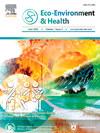Spatio-temporal dynamics of human-induced carbon emissions in Southeast Asia (1992–2022) based on nighttime light
引用次数: 0
Abstract
Understanding regional carbon emissions from human activities, particularly their spatio-temporal patterns, is essential for implementing decarbonization strategies and cultivating a low-carbon economy. This study develops a spatial visualization model to estimate carbon emissions in Southeast Asia using calibrated nighttime light data, with DMSP-OLS (Defense Meteorological Satellite Program Operational Linescan System) and NPP-VIIRS (National Polar-orbiting Partnership Visible Infrared Imaging Radiometer Suite) standardized through polynomial regression and machine learning to ensure consistency. Emissions in Southeast Asia increased by 2.51 times from 1992 to 2022, shifting from gradual to rapid growth. Validation against Open-source Data Inventory for Anthropogenic CO2 (ODIAC) and Emissions Database for Global Atmospheric Research (EDGAR) shows strong agreement in high-emission urban areas but discrepancies in low-emission rural regions due to data sparsity and satellite sensor limits. Spatial analysis reveals that major Southeast Asian cities and their peripheries exhibit robust, sustained growth, while rural, less-developed areas show slower trends, highlighting persistent urban-rural disparities. These urban regions demonstrate a “circular economy advantage”, where per-unit-area carbon emissions steadily rise in economically advantageous zones. Despite high model accuracy, uncertainties persist due to variations in regional economic activities and the limitations of satellite-based emission proxies. Forecasts suggest elevated emission levels in major cities will continue, while changes in other areas remain relatively minimal. Consequently, achieving a low-carbon economy in Southeast Asia requires a top-down approach, emphasizing infrastructure enhancement, resource and energy optimization, and fostering a sustainable, circular socio-economic system.

基于夜间光照的东南亚人为碳排放时空动态
了解人类活动造成的区域碳排放,特别是其时空格局,对于实施脱碳战略和培育低碳经济至关重要。本研究开发了一个空间可视化模型,使用校准的夜间灯光数据来估计东南亚的碳排放量,通过多项式回归和机器学习标准化DMSP-OLS(国防气象卫星计划操作线性扫描系统)和NPP-VIIRS(国家极轨伙伴关系可见光红外成像辐射计套件)来确保一致性。从1992年到2022年,东南亚地区的排放量增长了2.51倍,从缓慢增长转向快速增长。对人为二氧化碳开源数据清单(ODIAC)和全球大气研究排放数据库(EDGAR)的验证表明,在高排放的城市地区有很强的一致性,但由于数据稀疏和卫星传感器限制,在低排放的农村地区存在差异。空间分析显示,东南亚主要城市及其周边地区呈现出强劲、持续的增长,而农村、欠发达地区的增长趋势较慢,凸显了持续存在的城乡差距。这些城市区域表现出“循环经济优势”,在经济优势区域,单位面积碳排放量稳步上升。尽管模式精度很高,但由于区域经济活动的变化和基于卫星的排放代理的局限性,不确定性仍然存在。预测显示,主要城市的排放水平将继续升高,而其他地区的变化相对较小。因此,在东南亚实现低碳经济需要自上而下的方法,强调加强基础设施,优化资源和能源,并培育可持续的、循环的社会经济体系。
本文章由计算机程序翻译,如有差异,请以英文原文为准。
求助全文
约1分钟内获得全文
求助全文
来源期刊

Eco-Environment & Health
环境科学与生态学-生态、环境与健康
CiteScore
11.00
自引率
0.00%
发文量
18
审稿时长
22 days
期刊介绍:
Eco-Environment & Health (EEH) is an international and multidisciplinary peer-reviewed journal designed for publications on the frontiers of the ecology, environment and health as well as their related disciplines. EEH focuses on the concept of “One Health” to promote green and sustainable development, dealing with the interactions among ecology, environment and health, and the underlying mechanisms and interventions. Our mission is to be one of the most important flagship journals in the field of environmental health.
Scopes
EEH covers a variety of research areas, including but not limited to ecology and biodiversity conservation, environmental behaviors and bioprocesses of emerging contaminants, human exposure and health effects, and evaluation, management and regulation of environmental risks. The key topics of EEH include:
1) Ecology and Biodiversity Conservation
Biodiversity
Ecological restoration
Ecological safety
Protected area
2) Environmental and Biological Fate of Emerging Contaminants
Environmental behaviors
Environmental processes
Environmental microbiology
3) Human Exposure and Health Effects
Environmental toxicology
Environmental epidemiology
Environmental health risk
Food safety
4) Evaluation, Management and Regulation of Environmental Risks
Chemical safety
Environmental policy
Health policy
Health economics
Environmental remediation
 求助内容:
求助内容: 应助结果提醒方式:
应助结果提醒方式:


